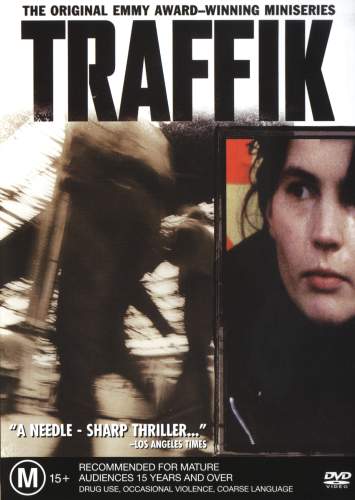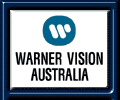Traffik (Warner Vision) (1989) |
|
Traffik (Warner Vision) (1989) |
|


|
| BUY IT |
| General | Extras | ||
| Category | Drama | None | |
| Rating |

|
||
| Year Of Production | 1989 | ||
| Running Time | 304:15 (Case: 325) | ||
| RSDL / Flipper |
RSDL Dual Disc Set |
Cast & Crew | |
| Start Up | Menu | ||
| Region Coding | 1,2,3,4,5,6 | Directed By | Alastair Ried |
|
Studio
Distributor |
 Warner Vision |
Starring |
Bill Paterson Lindsay Duncan Julia Ormond Jamal Shah Fritz Müller-Scherz Vincenzo Benestante |
| Case | Amaray-Transparent-S/C-Dual | ||
| RPI | $19.95 | Music | Tim Souster |
| Video | Audio | ||
| Pan & Scan/Full Frame | Full Frame | English Dolby Digital 2.0 (224Kb/s) | |
| Widescreen Aspect Ratio | None | ||
| 16x9 Enhancement | No | ||
| Video Format | 576i (PAL) | ||
| Original Aspect Ratio | 1.33:1 | Miscellaneous | |
| Jacket Pictures | No | ||
| Subtitles | None | Smoking | Yes |
| Annoying Product Placement | No | ||
| Action In or After Credits | No | ||
I saw Steven Soderbergh’s adaptation of this mini-series for an American audience the day it opened, knowing that it was not an entirely original piece. Being a fan of Soderbergh for some time by that point, I was interested to see what he would do with a script that was intentionally written for a European audience in the 1980s. I was highly impressed, and Traffic remains one of my favourite films to this day. When I was given an opportunity to review the original 6-hour mini-series Traffik, scripted by Simon Moore and directed by Alastair Ried, I jumped at the chance.
Traffik is an interwoven story following at least four intersecting plotlines. There is the British Member of Parliament, Jack Lithgow (Bill Paterson), who has recently travelled to Pakistan to look at aid options to curb the heroin trade. His daughter, Caroline (Julia Ormond), is a student with a heroin problem of her own which is only revealed to Jack after he returns from his trip. Then there is the Pakistani heroin grower, Fazal (Jamal Shah), who has been thrown off his land by the Pakistani army for refusing to stop growing opium poppies. Crippled by a gunshot wound through the hand, he turns to drug baron Tariq Butt (Talat Hussain) for money to feed his family. In Hamburg, we have two detectives, Ulli (Fritz Müller-Scherz) and Dieter (Tilo Prückner), who have just made a huge heroin seizure and have a witness implicating a legitimate businessman, Karl (George Kukura), with construction contracts in Pakistan helping the farmers grow produce other than opium. And we have Karl’s British wife Helen (Lindsay Duncan), who lives in Hamburg with her children. When her husband is arrested, she begins taking over the business with the aid of her husband’s lawyer Domenquez (Vincenzo Benestante).
Traffik is a stunning series, not only for its day, but for any day. This is what all mini-series should be like – tough, original, flawlessly produced and flawlessly acted. It is engrossing from the first episode to the last, offering no easy answers and asking many tough questions. In its capacity for storytelling, it rivals mini-series such as Brides Of Christ and Band Of Brothers. It lacks the production value of the latter, but probably bests the former in terms of its technical flair, and I found it extremely hard to fault. Better yet, it examines in intricate detail just how complex the drug trade is, and how futile it is to wage a war particularly when the issues are misconstrued and misunderstood and lines are not so easily drawn between good and evil.
If you want to see where Soderbergh got his inspiration from, check out this excellent TV masterpiece. You will not be sorry.
Presented in 1.33:1, Full Frame, this is the original aspect ratio for the series.
Sadly, the quality of the picture is not so good, obviously being transferred from a VHS master. The quality of the transfer is no better, and probably a little worse, than that of Brides Of Christ.
There is persistent and sometimes oppressive graininess, particularly in shots where the lighting is shadowy or subdued. Shadow detail is quite bad, and occasionally the picture looks like a dark smudge rather than a well defined image.
Colour is very muted, lacking saturation and looking very ‘worn’. While not the intentional acid wash bleached look of films like Saving Private Ryan or Minority Report, the look is kind of getting there, and it looks all wrong as a result. Cross-colouration crops up repeatedly on grilles and suits and textured ties.
There are several film-to-video transfer problems, some worse than others. The graininess results in low-level noise which can be quite apparent on blue skylines and white walls. There is a brief MPEG glitch at 5:03 during Part Five. There are lots of videotape transfer faults, including a tracking ‘flutter’ at 29:53 during Part One, a persistent and very distracting tracking fault running along the top of Part Three throughout the whole episode, and a fold in the tape at 33:27 - 34:08 during Part Six.
Film artefacts were noticeable, with several large specks of dirt or clusters of smaller dots here and there and the odd hair or line on the picture.
Subtitles in the foreign language sequences are white inside a slightly off coloured dialogue box that alters the colour of things behind it. This can be quite annoying.
The dual-layer pause is during the second episode on both discs — at 25:53 during Part Two and at 26:12 during Part Five. The first occurs during a scene change and is barely noticeable. The second occurs in the middle of a scene and is more distracting.
| Sharpness | |
| Shadow Detail | |
| Colour | |
| Grain/Pixelization | |
| Film-To-Video Artefacts | |
| Film Artefacts | |
| Overall |
There is only the original audio track here, presented in Dolby Digital 2.0 Mono. This is not an ‘English’ track per se, as the series takes place in the UK, Germany and Pakistan, and in each locale the native language is used. However, all the foreign language sections are subtitled.
Dialogue lacks real clarity, and can sometimes be a touch hard to hear, especially if it is a recorded voice or a voice on the other side of a telephone conversation. There were no real audio sync problems that I detected.
Because this is a monaural track, there is nothing in the way of directional cues or surround use, and no subwoofer use. There is, however, a low-level persistent hiss, sometimes a hum, running along the background of the audio track that is distracting once you are aware of it. This fault is pervasive.
The only place this show scores any real points is in its rendering of the evocative and haunting score by Tim Souster. This is a very nice piece of work, and although obviously digitally created, it still sticks in one’s memory and perfectly complements the action on the screen.
| Dialogue | |
| Audio Sync | |
| Clicks/Pops/Dropouts | |
| Surround Channel Use | |
| Subwoofer | |
| Overall |
All menus are presented in 1.33:1, non-16x9 enhanced. They are static and silent.
NOTE: To view non-R4 releases, your equipment needs to be multi-zone compatible and usually also NTSC compatible.
The R1 release of this DVD set also has an interview with Simon Moore (writer) and Brian Eastman (producer). However, all reports suggest that the audio and video quality are pretty much the same.
Traffic is seminal piece of TV viewing, and we should be so lucky as to be graced with something this good on the small screen once a year. Sadly, we are very rarely so fortunate.
The video is not the best, let down by its videotape source. Sadly, digital editing came too late to save this.
The sound is a less-than-dynamic 2.0 Dolby Mono mix that does the job but does not really bring the show home.
There are no extras.
| Video | |
| Audio | |
| Extras | |
| Plot | |
| Overall |
| Review Equipment | |
| DVD | Panasonic DVD-RV31A-S, using S-Video output |
| Display | Beko 28" (16x9). This display device is 16x9 capable. |
| Audio Decoder | Built in to amplifier/receiver. |
| Amplification | Marantz SR7000 |
| Speakers | Energy - Front, Rear, Centre & Subwoofer |